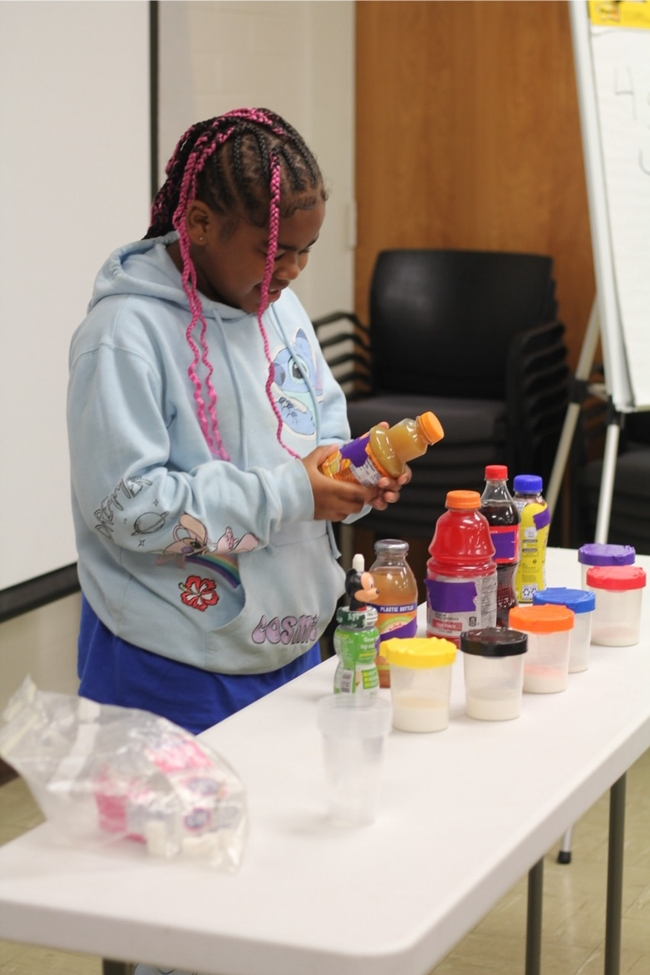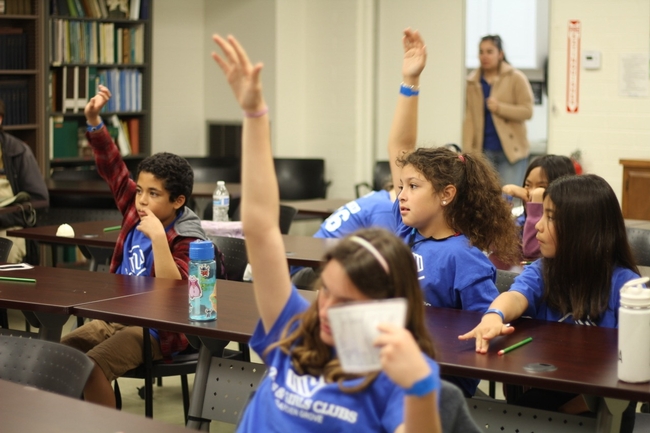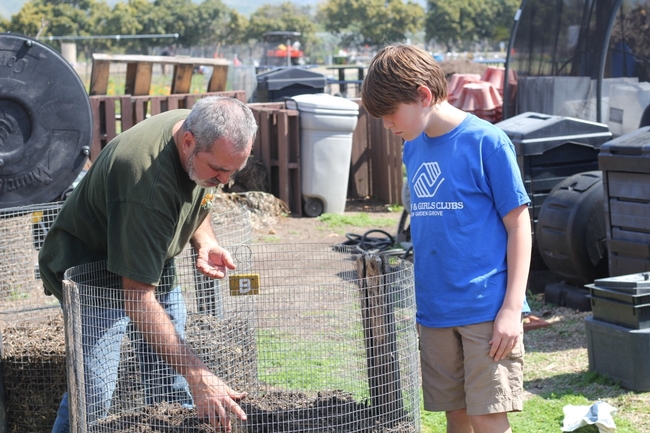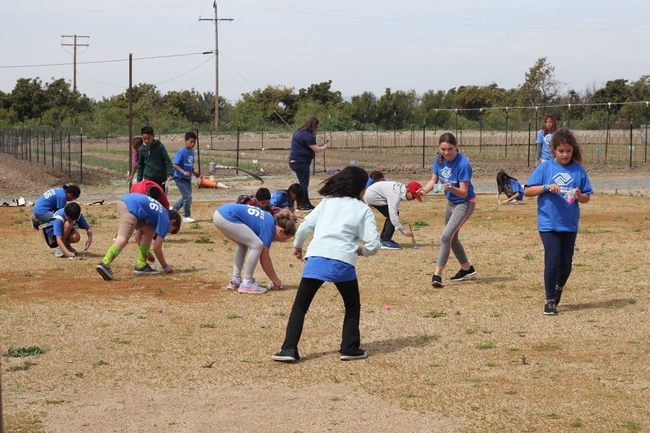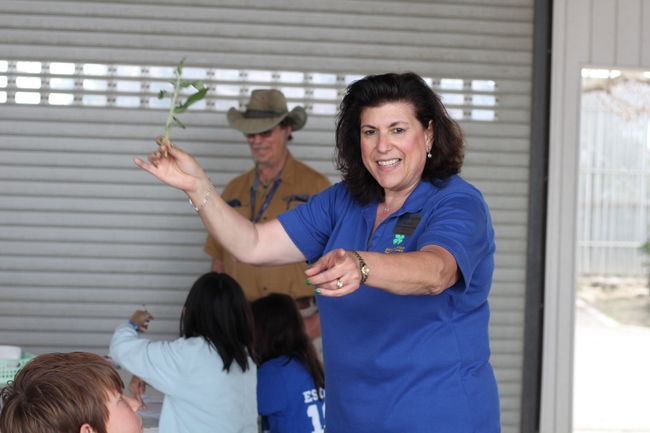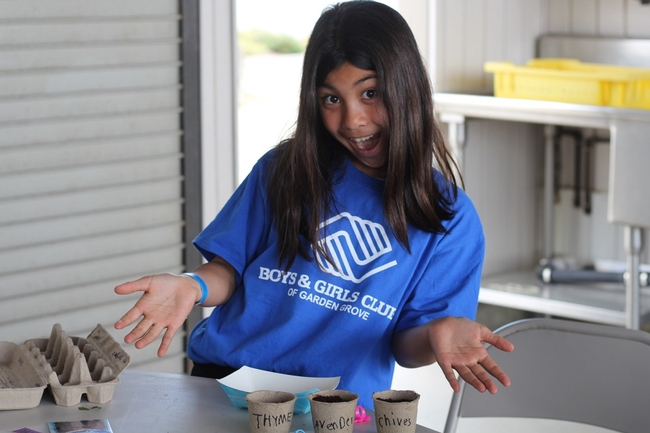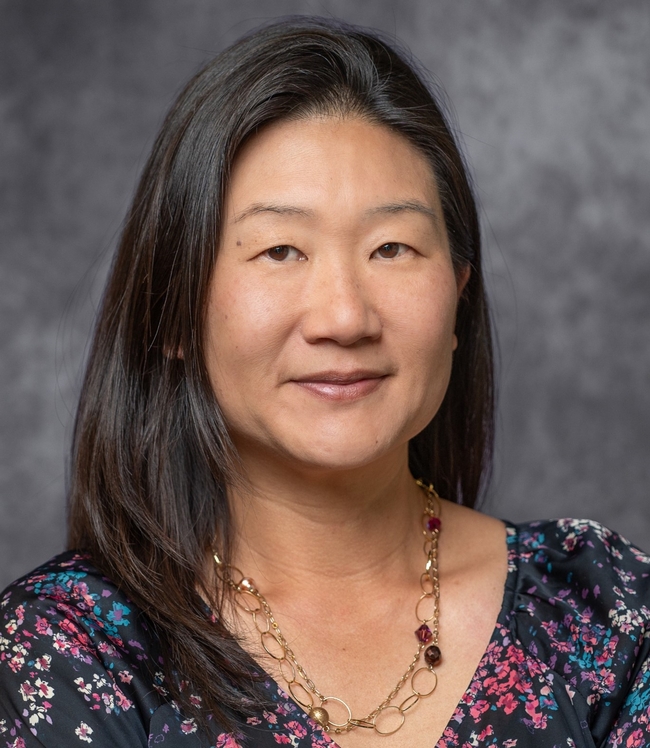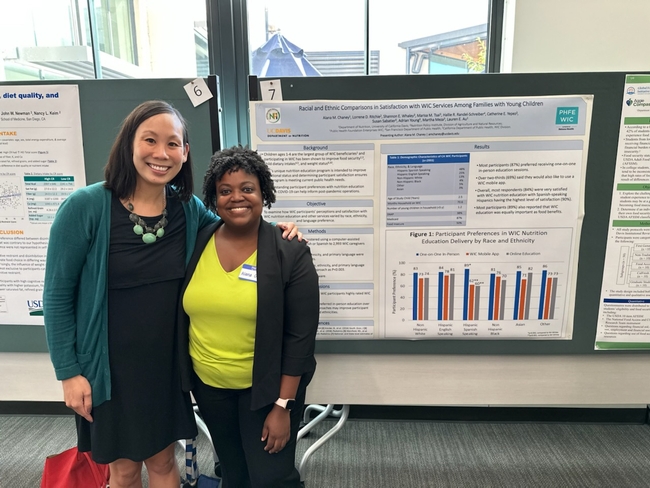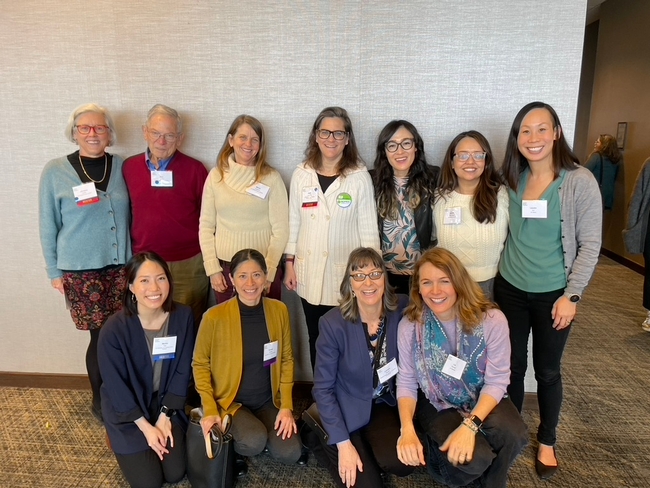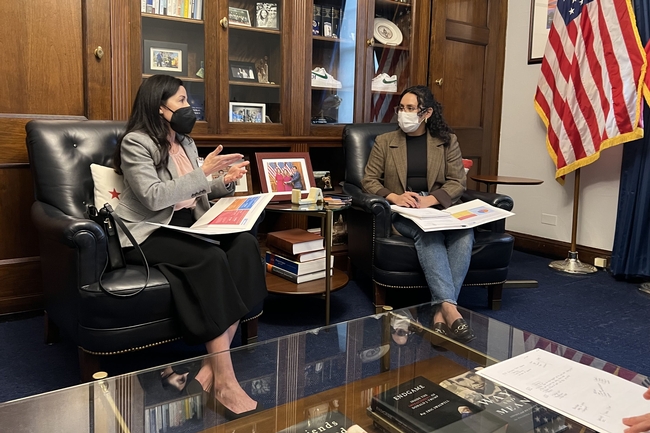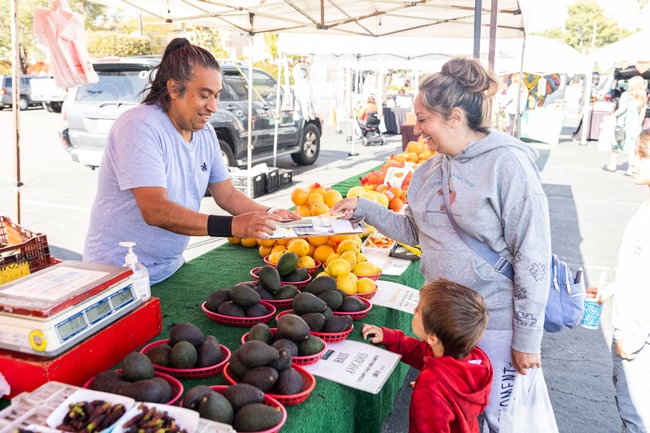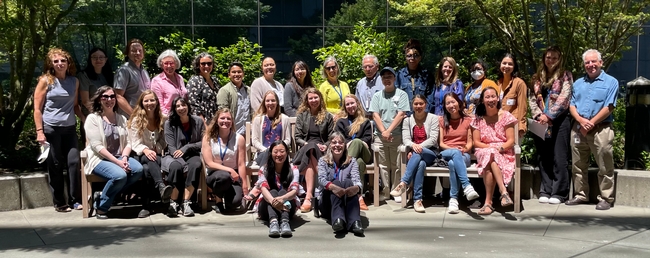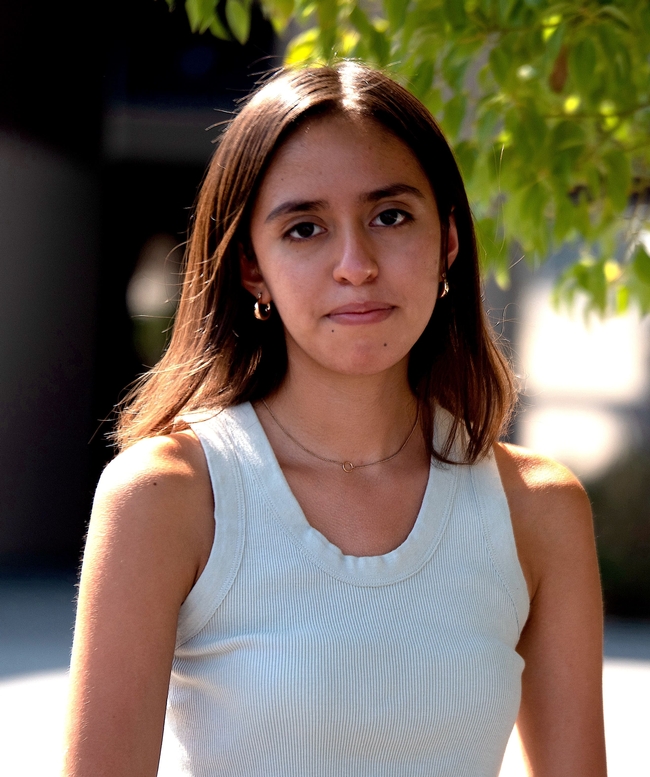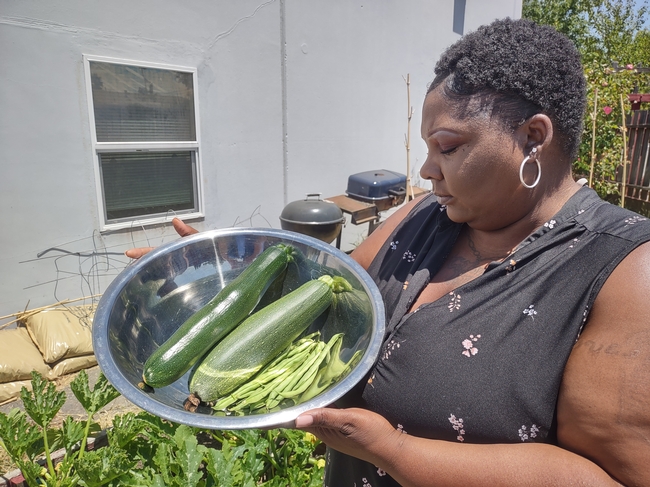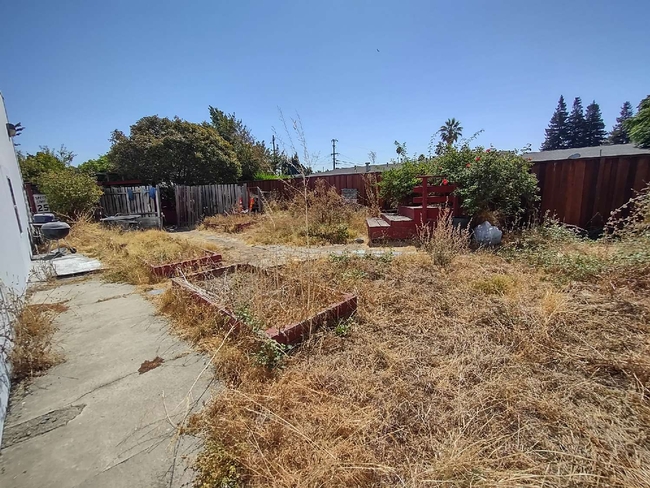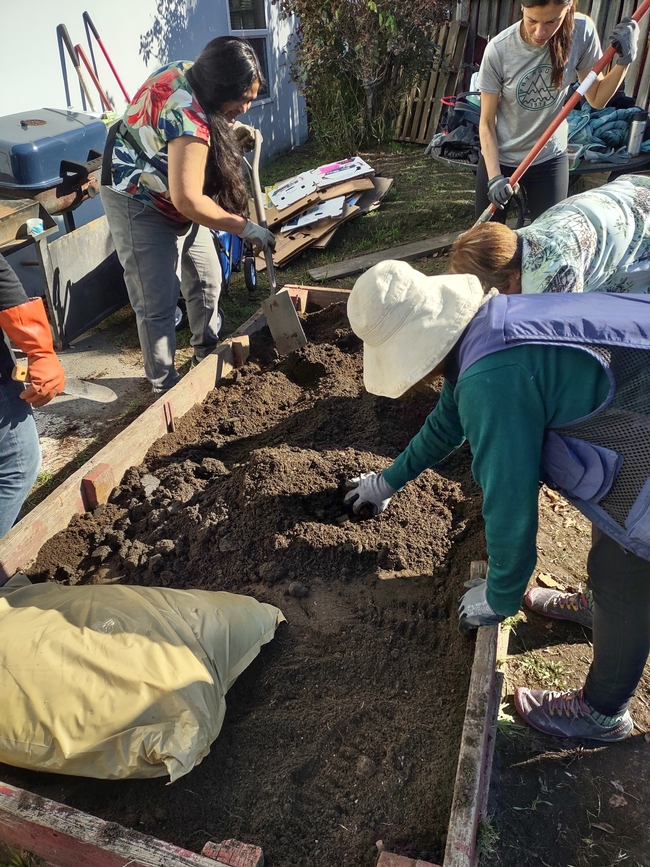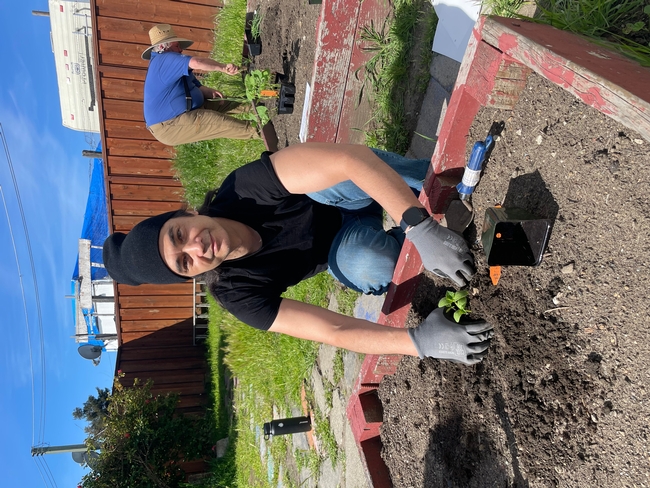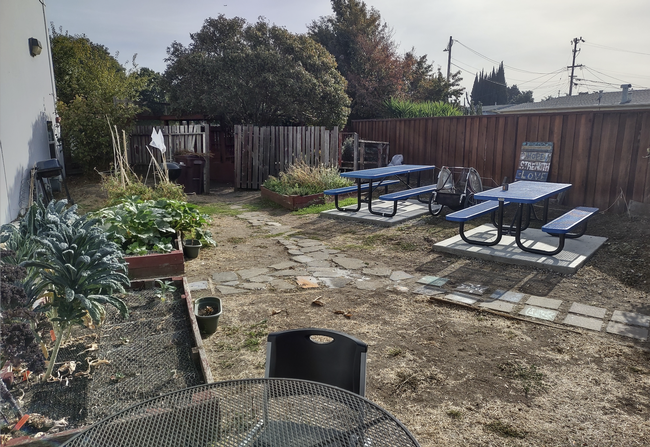Posts Tagged: Nutrition
UC seeks toddler volunteers for milk study
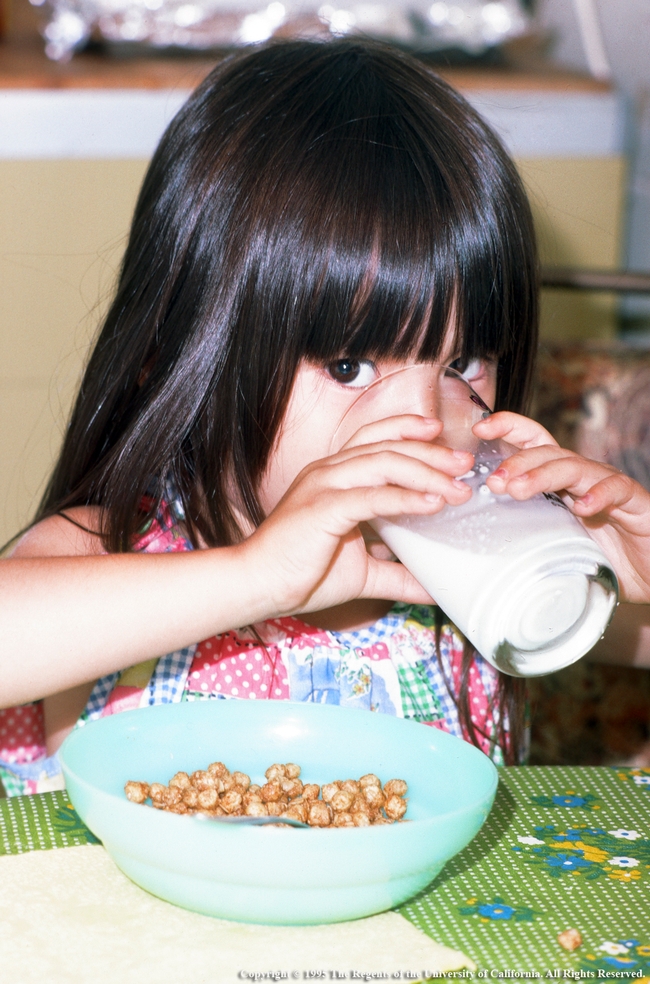 UC researchers will study effects of whole milk and low-fat milk on toddlers' health and development.
UC researchers will study effects of whole milk and low-fat milk on toddlers' health and development.

Researchers to study whether whole or low-fat milk is best for toddlers
San Francisco Bay Area toddlers who drink cow's milk are being sought to participate in a 12-month study by UC Nutrition Policy Institute, a part of University of California Agriculture and Natural Resources. Milk will be provided for free to participants.
Milk provides children with calcium, protein and vitamin D, which are essential for health and brain development. In the U.S., the American Academy of Pediatrics recommends that children switch from whole milk to low-fat or nonfat milk after age 2 to reduce their intake of saturated fat and calories.
“The purpose of this UC study is to see how the type of milk toddlers drink affects their health, growth and development,” said Kassandra Bacon, NPI project policy analyst.
Researchers with the Nutrition Policy Institute are recruiting children ages 23 to 30 months old. The 625 toddlers will be randomly assigned to drink either whole fat or 1% fat milk starting at age 2. The scientists will assess diet, health and developmental outcomes.
“We will follow each participant for one year, collecting baseline and follow-up data,” said Ryan Williams, a NPI project policy analyst and registered dietitian who is involved in the research.
For 12 months, the scientists will measure each child's height, weight, waist and head circumference. At the beginning and end of the study, parents will be required to take their children to a local lab for a blood draw to assess lipids, cholesterol, insulin resistance and vitamin D status, as well collect a sample of their child's stool so the scientists may analyze the gut microbiome. During a home visit, researchers will also interview parents about their child's development.
Benefits to participants
The assigned milk type will be delivered to participants free of charge via a grocery delivery service. Participating parents will receive advice from a registered dietitian to support healthy milk consumption as part of a balanced diet. The Nutrition Policy Institute also will send the parents monthly newsletters with general health tips. Participants also may earn up to $275 in gift cards by completing the study.
Requirements to participate
Participants for the milk study must meet these requirements:
- Child must be 23 to 30 months old and have public or private medical insurance
- Child's parent/legal guardian must be 18 years or older
- Child must live with the participating parent/legal guardian in the San Francisco Bay Area (Alameda, Contra Costa, Marin, Santa Clara, San Francisco or San Mateo counties)
- Child's parent or guardian must speak English
Children are ineligible for the study if they are:
- a WIC participant
- lactose intolerant
- allergic to milk protein
Lorrene Ritchie, NPI director and registered dietitian, and Anisha Patel, pediatrician at Stanford Medicine Children's Health and professor in the Division of General Pediatrics at Stanford University, are the principal investigators for the study.
For more information about the research and to sign up for the study, visit https://npi.ucanr.edu/milk.
4-H, Boys and Girls Club, UCCE partner to inspire Orange County kids
Small containers with varying levels of sugar sit next to a row of beverages, including water, fruit juices, soda, a sports drink and chocolate milk. Trying to match each container with the beverage that contains its corresponding amount of sugar, Amore, a fourth grader, reads the nutrition label on the orange juice bottle. “What does the bottle say?” asked a student in the audience, attempting to help Amore.
Life skills such as how to read a nutrition label are representative of learning that youth can expect when joining 4-H, a nationwide program focused on empowering kids ages 5 to 18. 4-H offers experiential learning opportunities ranging from STEM (Science, Technology, Engineering and Mathematics) and healthy living to civic engagement and leadership.
To expand its reach and make their program more accessible, 4-H launched a digital learning platform called CLOVER by 4-H that offers content tailored for three types of users: learner, parent and educator. As the platform grows in popularity, 4-H is eager to identify best practices in engaging new users to join the platform and retain their interest.
More than 250 free 4-H lessons
In California, 4-H programs are overseen by University of California Agriculture and Natural Resources. Given its successful contributions to statewide initiatives in the past, 4-H in Orange County, administered through the local UC Cooperative Extension office, was one of three counties selected to participate in a CLOVER pilot project in conjunction with the National 4-H Council. With more than 250 4-H lessons available online at no cost, the pilot project aims to introduce its users to 4-H.
To generate interest, 4-H in Orange County is leveraging connections to local Boys and Girls Clubs. In March, they hosted more than 20 kids from the Boys and Girls Club of Garden Grove (BGCGG) – including Amore – for a day of learning and exploration at the UC South Coast Research and Extension Center in Irvine, where the 4-H program for Orange County is based.
Rita Jakel, community education specialist and program coordinator for 4-H of Orange County, said that partnering with BGCGG will, hopefully, inspire its members to join their local 4-H club.
“The youth created a CLOVER account before engaging in eight CLOVER lessons taught by the staff at the Boys and Girls Club during their weeklong Spring Break Day Camp,” said Jakel, noting that the participants were introduced to 4-H before arriving to South Coast REC for in-person activities.
Interactive nutrition and gardening lessons
During their visit, the participants engaged in a typical day of 4-H lessons featuring presentations from the local Expanded Food and Nutrition Education Program (EFNEP) and UC Master Gardener volunteers. Jakel then wrapped up with interactive sessions on animal adaptations—understanding the challenges animals face in gathering food—as well as lessons on growing and cooking with herbs.
“One of the most rewarding aspects of working with young people is the opportunity to creatively educate them on various subjects, ensuring that learning is both enjoyable and engaging,” said Javier Miramontes, community nutrition and health supervisor for EFNEP in Orange and Los Angeles counties, who started the day off with the lesson on nutrition labels.
Miramontes visually explained how much sugar is found in various beverages and then challenged the students to do so on their own. “It's important to me that all students participate, as engagement is key at their age, not only for inclusivity but also to maintain their focus,” he said. Miramontes concluded with a review of his lesson and was pleased that most of the class demonstrated a solid understanding of the key topics.
While the intention of CLOVER is to introduce users to 4-H in hopes that they would want to become members of their local clubs, Jakel believes that participating through CLOVER could be just as effective, if not more. “We're testing out the idea of bringing kids to our facility for typical 4-H programming. If they like it, our hope is that they'll sign up on CLOVER and gain access to our educational approach there,” said Jakel.
4-H in person and online
The goal is to give youth options so that the 4-H experience, whether in person or online, does not feel out of reach.
When discussing their collaboration, Jakel said that the BGCGG staff would continue to support interested kids and their families with CLOVER registration. The staff also agreed to conduct programming based on the digital platform at their facility to continue exposing BGCGG members to all that 4-H has to offer, which they have already reported as easy to implement and engaging among the youth.
During their time in the garden, members learned about vermiculture and how worms are essential for compost. Mary Nguyen, STEM specialist for BGCGG, said that she enjoyed watching the youth light up when they are playing in the dirt and learning about how fruits can be combined to produce new generations. To wrap up their visit to the garden, the group received a small worm box to use for their own school garden.
“I hope that more fun field trips – and hands-on activities involving research that youth can participate in – will come from our partnership with South Coast REC and 4-H,” Nguyen said.
Field trips to see, touch, smell and taste
From a UC Master Gardener's perspective, the youth were extremely interested in learning about everything and asked many questions. “I loved their curiosity,” said UC Master Gardener volunteer Laura Holly, who helped with the garden demonstration and tour of UC South Coast Research and Extension Center. “They wanted to know why certain pipes were painted purple (to indicate reclaimed water), about the windmills and how avocado trees are grafted.”
“More children would benefit from seeing how the trees that produce the fruit they eat grow,” Holly added.
Hannah, a fourth grader, said that she loved the lesson on herbs that Jakel led before the participants boarded the bus to return home. All members got to see, touch, smell and taste four different herbs before planting their own to take home. “I had a lot of fun. I think if I had to grow one thing, it would be chives. They actually taste really good,” Hannah said.
Amore, who knew what lavender smelled like before, had never seen a lavender plant. “My mom loves lavender, but I didn't know this is what it looks like. I planted some lavender to take home for her,” she said.
The partnership with BGCGG is one of many that Jakel hopes to foster in Orange County, in addition to uniting UCCE programs to enrich the learning experience for youth who visit South Coast REC and those enrolled in the 4-H program. Her goal, in line with that of CLOVER, is to make 4-H programming more accessible for the youth, parents and educators alike.
To learn more about 4-H in Orange County, visit https://oc4h.org/.
Nutrition Policy Institute: 10 years of making healthy choices more accessible for all
NPI researchers provide influential evidence that shapes federal, state nutrition programs
Of the many challenges facing humanity, nothing is more fundamental than securing healthy food and water for all. Life itself would not be possible without nutrients, energy and water – but for many people across the United States, that essential fuel is compromised.
“Right now, the average American diet quality has a failing grade,” said Lorrene Ritchie, University of California Cooperative Extension nutrition specialist. “If you scored it from 0 to 100, it would be about 55 to 60. And we're trying to move that number closer to 80.”
To help society reach that goal, the Nutrition Policy Institute was established 10 years ago, under the UC Agriculture and Natural Resources umbrella.
“NPI was created in recognition of the fact that more people in the United States are now ill with a nutrition-related chronic disease than are well,” said Ritchie, who has been director of the institute since its founding. “Six in 10 adults in the U.S. have one or more chronic diseases – 4 in 10 have two chronic diseases – that are preventable. When you have that big of a public health nutrition problem, the scope requires big policies, big program changes and big environmental changes.”
Since 2014, NPI – building upon the work of the Center for Weight and Health at UC Berkeley – provides scientific data to inform and guide a host of nutrition improvements across wide swaths of the population, with a focus on low-income and racially and ethnically diverse communities.
The work of NPI's 40 academics, staff and students have furnished policymakers, program managers and school administrators with the pivotal research that, among other things, has enhanced access to federal nutrition programs, reduced food insecurity for children of all ages, and removed unhealthy snack foods and beverages from schools while boosting access to drinking water.
And with about 1 in 3 people in the U.S. touched by federal nutrition programs, NPI experts have become instrumental in evaluating programs such as SNAP (Supplemental Nutrition Assistance Program, popularly known as food stamps or CalFresh in California) and SNAP-Education, WIC (Special Supplemental Nutrition Program for Women, Infants and Children), school meal programs, and the Child and Adult Care Food Program.
“This institute is the only one of its kind on the West Coast, with a very substantial number of graduate-level nutritionists and policy experts who are ready and able to take on policy questions that are being considered at the federal, state and local levels,” said Pat Crawford, a pioneer in the field of nutrition policy and the founding director of the UC Berkeley Center for Weight and Health, which merged with NPI in 2015.
In assessing NPI's overall contributions to the nutrition and public health space, Ritchie is astonished by the work of its academics and staff.
“Our findings have really informed policy and moved the field in a way that I could have hardly conceived of 20 or 30 years ago, when I first started working in this area,” she said. “I could not imagine that we would have achieved all the policy impacts that we have.”
Trusted partners in researching school meal programs
An illustrative example of NPI's prominence in nutrition policy research is its leading role in studying California's effort to provide school meals for all students.
The Nutrition Services Division of California's Department of Education oversees virtually all meal programs in public schools across the state, serving 870 million meals and snacks each year to about 5.8 million students.
According to its director, Kim Frinzell, the division relies on NPI to help evaluate and understand the emerging trends at schools by gathering and analyzing feedback from students, teachers, food service directors, parents, community organizations and other partners. With a better pulse on these trends, Frinzell's team uses the data to inform its policies, practices, training and overall strategy.
“NPI brings the expertise of knowing what kind of research questions to ask; as a state agency, we don't have research resources, nor the specific expertise,” Frinzell said. “So being able to partner with NPI is an incredibly valuable service.”
In addition to working with Christina Hecht on drinking water access and Wendi Gosliner on food waste issues, the California Department of Education has partnered with NPI researchers in recent months to conduct surveys and organize focus groups on California's universal school meals program, School Meals for All.
Coming out of the COVID-19 pandemic, California was one of the first states in the U.S. to adopt a universal school meals program, offering breakfast and lunch at no cost to all K-12 students, regardless of household income. NPI was funded to evaluate the implementation and impact of the program.
“The great value of what NPI brings to School Meals for All is that their work is not just quantitative but qualitative, value-added information that tells a story about real individuals and real situations that is backed by the data about a particular program, and you're able to anchor back to a very well-respected institute and the research they've done and say: ‘This is what the survey says, this is what the evaluations and the data provide,'” Frinzell explained.
“What's been really wonderful about NPI over the past 10 years is they're such leaders in studying and helping to create strategies for greater access to healthy meals for all – while also promoting healthy habits for all – across the entire child-nutrition spectrum,” Frinzell added.
Pioneers in researching universal school meals
May Lynn Tan was one of the first students working at NPI. She was interested in learning about universal school meals and accessed data on meal programs from across the U.S. using Lorrene Ritchie's work on a nationwide collaborative school nutrition project.
“At the time, there was not a lot of evidence on the impact of universal meals on participation, because there just weren't that many places where that was happening,” Tan said. “So that data set really helped illustrate some of these patterns that I wouldn't have been able to get at, otherwise.”
Tan chose this topic for her doctoral dissertation. She concluded that students who previously had been ineligible for free or reduced-price meals experienced the greatest impact through universal school meal programs. “It really just went to show that when you offered universal meals in schools, the kids who weren't qualified to get them for free before, but who still needed them, could start participating at a higher rate,” said Tan, noting that her research continues to be used in modeling to predict the effects of such programs in other states.
Presently, as director of research and strategic initiatives for California Association of Food Banks, Tan is thankful for her relationships with NPI team members – and regularly accesses NPI resources and briefs (compiled by NPI communications director Danielle Lee, in collaboration with other NPI researchers) to stay abreast of the latest research.
“NPI does a really good job packaging their findings for practitioners who are managing and providing services for communities,” Tan said. “That's really important in this field, because policymakers and program staff don't necessarily want to wade through a giant study. NPI often puts out one-pagers and things that are more graphically designed that make it easy to understand the findings – and what they mean for the real world.”
Experts in examining WIC program policies, impact
In the early 2010s, Lauren Au was working in Washington, D.C. as a U.S. Senate nutrition advisor, providing lawmakers with the latest research on nutrition programs. But she sought a more active role in the field.
“Instead of being the legislative assistant who's meeting with constituent groups that are giving me their one-pagers about why their legislation should be supported, I wanted to be driving the research that's behind that one-pager,” Au explained.
Having studied with Pat Crawford as an undergraduate student at UC Berkeley, Au returned to the West Coast in 2014 as a postdoctoral researcher with NPI. One of her projects was a long-term study of children, from birth to age 9, participating in the WIC program.
Au's experience in studying WIC – including its pandemic-era changes that increased fruits and vegetables and offered online options for participant enrollment, recertification and education – allowed her to carve out her own niche in the academic space. She cited that research focus, along with the collaborative relationships she cultivated at NPI, as major reasons for her success as a recently tenured professor in the Department of Nutrition at UC Davis.
“I love this work because you're constantly learning and keeping up with where the field is going,” Au said. “I've seen, over time, how it's changed from focusing on obesity to now focusing more on the social determinants of health. And that's where my research has shifted as well, becoming broader and seeing how all these environmental influences play a role in impacting nutrition and public health.”
Trailblazers in studying policy, systems and environmental approaches
NPI's work has been a driver of the field expanding its focus to research and interventions beyond the individual (such as direct education efforts) to the social, cultural and environmental context.
“We know now that nutrition is absolutely one of the determinants of all of the chronic diseases that we're suffering from in this country, whether it be cancer, heart disease, stroke, diabetes or obesity,” said Crawford, emeritus CE nutrition specialist and adjunct professor of public health. “And we've learned that it takes more than just educating people – it really takes policymakers to help make those good, nutritious choices easier for the public.”
Sugar-sweetened beverages, for example, have a significant negative impact on children's diet quality and health, according to Ritchie. And because such beverages are heavily marketed and ubiquitous, parents and caregivers are challenged to make the right choice – even if they know about their harms.
“Regardless of the quality of the education, the onus is on the parents to remember to make the healthy choices, which can be hard when kids naturally love sweets, and given the influence of kids' ‘pester power,'” Ritchie explained.
To help those dietary decision-makers, a bill was passed in California to make the healthy choice (i.e., milk or water) the “default” beverage offered with kids' meals served in restaurants. Since that law went into effect in 2019, its efficacy – and shortcomings in practice – and have been extensively studied by NPI's CalFresh evaluation team.
Innovators in SNAP, SNAP-Ed evaluation
Federally funded by the United States Department of Agriculture, the California Department of Public Health oversees SNAP-Ed (known as CalFresh Healthy Living at the state level) as the largest of four CFHL state implementing agencies to fund work in California's 61 local health departments. CDPH contracted with NPI (and before that the Center for Weight and Health) to conduct ongoing comprehensive evaluation of CalFresh Healthy Living interventions, including individual education and behavior change as well as broader systems approaches.
“NPI has been a wonderful partner and contributed a tremendous amount in how CalFresh Healthy Living evaluates its work, especially as policy, systems and environmental change approaches have evolved and been encouraged over the years,” said Erica Eilenberg, chief of CDPH's Nutrition and Physical Activity Branch.
While developing more efficient systems and processes for tracking, evaluating and reporting results of CalFresh Healthy Living initiatives across California, NPI also provides technical assistance to local health departments in collecting crucial data and measuring outcomes. In particular, NPI researchers helped develop an innovative “dose score” method to quantify the cumulative and combined impact of multiple interventions at school sites – as opposed to measuring each type of intervention independently.
As a result, more robust evaluation data and reporting have provided local health departments with key information to improve their program planning and delivery.
“NPI's evaluation work has resulted in more effective initiatives that have contributed to improving food and nutrition access for many CalFresh Healthy Living-eligible participants across California,” said Eilenberg, who added that NPI academics are valued contributors to state-level workgroups and national committees advising SNAP-Ed.
Respected voices on food insecurity, nutrition in higher education
One of the many NPI-affiliated researchers who have become prominent voices at the national level, Suzanna Martinez was among the 500 invited attendees at the 2022 White House Conference on Hunger, Nutrition and Health – the first convening of its kind since 1969. Many of the conference's recommendations, outlined in the Biden-Harris administration's national strategy, are supported by research underpinnings from NPI and its partners.
Martinez was invited to the conference because she's part of a UC effort to halve, by 2030, the number of students in the UC system who are facing food insecurity – meaning they are regularly unable to access enough food for a healthy lifestyle.
Now an associate professor in the Department of Epidemiology and Biostatistics at University of California San Francisco, Martinez said her research on student food security in higher education was a direct result of her time at NPI. One of the first researchers to join NPI in 2014, she began working with Ritchie on a groundbreaking, systemwide survey about food security across the UC system.
“Up until that point, there had only been some smaller studies, convenience sample surveys of community college students, and so this was one of the bigger studies to look at this issue in a large public university system,” said Martinez, who noted that she had to be resourceful to avoid being food insecure as a graduate student.
Their initial study found that 4 in 10 UC students were facing food insecurity – a startling statistic that provided hard evidence to policymakers on the need for additional funding and resources, such as campus food pantries. In subsequent years, Martinez and NPI colleagues partnered with staff at UC campus basic-needs centers to pinpoint the barriers preventing greater student access to food assistance – and offered potential ways to streamline processes.
Follow-up surveys indicated improvement in food security at UC locations, until the pandemic halted that progress. Nonetheless, Martinez – who continues to intensively study the subject – said that NPI's broad platform was crucial in spotlighting food needs at colleges and universities.
“It was important, at that time, that this work came out of NPI,” she said. “I don't think it would have had as much impact as it has had because of where the work was coming from.”
Growing as a key source of research in food systems
The depth and breadth of NPI's influence is even more striking given the “youth” of nutrition policy as a field in public health nutrition, which dates back only about 50 years.
“For the applied nutrition policy research that we do at Nutrition Policy Institute, it's only in the last couple of decades that we've really been doing research to see how policy, systems and environmental change can support behavior changes of everyday people like you and me,” Ritchie said.
She pointed out that NPI's partnerships are key to expanding its reach. Partners assist in bringing NPI's rigorous research to legislators, policy staff and the people who manage and deliver nutrition programs. By working with state entities like the Departments of Education, Public Health, Social Services, and Food and Agriculture – as well as organizations such as the California and National WIC Associations, CACFP (Child and Adult Care Food Program) Roundtable and the Center for Science in the Public Interest – NPI researchers provide key data to decision makers and advocates, and receive critical guidance on their research projects in return.
“We are researchers, but we are not on the ground implementing these programs and policies and we absolutely cannot do the work that we do without our partners,” Ritchie explained. “Asking the right questions of the right people is really hard to figure out if we don't have the community partners at the table.”
By virtue of its place alongside UC ANR experts on agriculture, natural resources and the environment, the NPI team is also connected to an even larger community of farmers, producers and other people along the food supply chain. Ritchie envisions, in the next decade, NPI taking a larger role in examining and improving the greater food system. As Wendi Gosliner and Ron Strochlic did through NPI's involvement in a recent project linking local growers with state correctional facilities, UC ANR can help connect the many scattered dots from farm to fork – from the food production side to the consumer nutrition side.
“Looking toward the future, that's the kind of thing I'm most excited about – helping those two arms, and everybody in between, talk to each other so that agricultural decisions are made thinking about human and planetary health, and nutrition decisions by consumers are made thinking about both planetary and human health,” Ritchie said. “We're going to need to do that to address climate change.”
‘We can see where the future is headed'
Meeting the challenges of the climate crisis – as well as incipient global health crises – will require a continued influx of talent, innovation and new ideas.
“The U.S. is now leading all nations in the prevalence of chronic disease, and what happens here, in terms of our food system, often gets exported all around the world,” Ritchie said. “We can see where the future is headed, and what we need to do is to figure out how to go back to a healthier lifestyle and a healthier diet. So the field of nutrition policy research, though there aren't that many of us, needs the brightest and best minds, the most enthusiastic and passionate people.”
The NPI Student Fellowship, established in 2019 in honor of Pat Crawford, has funded about a dozen students to work with NPI researchers on a variety of projects. While they gain hands-on research skills, glimpses of potential career paths, and access to nutrition professionals and resources, they also contribute their own diverse perspectives.
“We intentionally recruit students with this fellowship funding who bring a diversity of lived experiences.” Ritchie said.
“Students participate in interdisciplinary and cross-cultural discussions on research design and data interpretation,” Crawford added.
Brianna Aguayo, a second-year undergraduate studying nutritional sciences at UC Berkeley, is a first-generation Latina college student currently working at NPI through the fellowship program. Growing up in East Palo Alto, Aguayo saw how systemic barriers prevented community members from accessing vital nutrition assistance and resources.
Through her time at NPI, Aguayo has gained new insights on how researchers, policy analysts and communication specialists work together to generate the scientific evidence that can improve federal, state and local policies so they can potentially benefit more people. That knowledge will only enhance her ability to create positive change in her community, as she plans to incorporate that public health policy perspective along her journey to becoming a pediatrician.
“It's not just one sole person making this change,” Aguayo said. “But it really takes a group effort to help initiate change, and then make sure that that change is constantly being implemented.”
People interested in supporting and celebrating NPI's first decade of research, which has led to more healthful food offerings to vulnerable children and their families, can donate to NPI's Student Fellowship. It provides students from underrepresented groups the opportunity to work with NPI, learn from NPI and continue after graduation to improve nutrition for all. An anonymous matching gift of up to $10,000 will double every donation made through June 30, 2024.
College students eligible for food assistance deterred by confusing requirements
Modifying Farm Bill could reduce barriers to SNAP for students and improve nutrition
Inadequate access to food can harm college students' health and academic performance. A recent University of California research study in the Journal of Nutrition Education and Behavior investigated why UC students who are eligible for the federal Supplemental Nutrition Assistance Program (SNAP) – the nation's largest food assistance program – do not receive the benefit.
“Based on our study findings, eliminating the extra requirements for college students to qualify for SNAP would go a long way in ensuring that more eligible students get the support they need to meet their basic food needs,” said study coauthor Lorrene Ritchie, director of the UC Nutrition Policy Institute, which is part of UC Agriculture and Natural Resources.
A 2015 study by NPI found four in 10 UC students didn't have enough money to buy sufficient food for a healthy lifestyle. To promote better health, UC has taken steps to ensure students are aware of SNAP, established campus food pantries and other basic needs resources.
"In California, SNAP is known as CalFresh and despite policies and communication to improve college students' access to CalFresh, participation remains low, with approximately 78% of those eligible not receiving benefits," said lead study author Suzanna M. Martinez, associate professor in the Department of Epidemiology and Biostatistics at UC San Francisco.
For insight on why low-income UC students aren't receiving the benefits, Martinez, Ritchie and colleagues at UC San Francisco and Nutrition Policy Institute consulted county agencies that process student CalFresh applications. The researchers interviewed county staff in nine counties that are home to UC campuses: Alameda, Los Angeles, Merced, Orange, Riverside, San Francisco, Santa Barbara, Santa Cruz and Yolo.
While CalFresh benefits have mainly been paid by the federal government through the Farm Bill, counties contribute and county agencies are responsible for implementing policies, determining eligibility, processing applications and distributing funds.
“With the Farm Bill still up for reauthorization, these findings could provide insight into how to strengthen SNAP policy related to eligible students,” Martinez said.
The researchers conducted focus groups and interviews with county staff to determine how agency workers interpret the complex criteria for students to meet CalFresh eligibility.
Their questions focused on how students' applications differed from those of community members, steps taken when processing student applications, student-specific training and suggested improvements to the process.
Five central themes were identified in the interviews:
- More consistent policy dissemination and program administration is needed
- Student exemptions and the application process are perceived as challenges for students
- Key supports for successful student applications include carefully reviewing applications for potential exemptions, providing useful resources to students, and campus partnerships
- Tracking policy changes is burdensome
- Eliminating student rules and treating students as regular clients would be more equitable
The researchers found that CalFresh rules are challenging for students as well as the county agency staff.
Also, eligibility requirements, written over 50 years ago, are based on the assumption that college students are supported by middle-class families.
The research supports simplifying the student CalFresh process to increase participation for eligible students, especially for historically underrepresented racial and ethnic groups and low-income students for whom equitable access to CalFresh benefits is critical.
“Once students get confused or don't know what they need to do, they don't follow through with their application,” one CalFresh eligibility worker told the researchers.
During the COVID-19 pandemic, some federal and state requirements were waived or relaxed for students.
“The timing of this study resulted in a natural experiment since COVID-19-related SNAP modifications streamlined the student application process and reduced administrative burden,” Martinez noted. “These modifications alleviated some challenges discussed by county workers, confirming existing opinions to eliminate the student rules.”
Ritchie said, “We hope our research informs policy to remove some of the barriers so students no longer have as much difficulty getting the food they need.”
This study was funded by the California State Legislature, which provided funding to the University of California to address students' basic needs (UC Basic Needs Initiative).
Homeless people cultivate food, better health while gardening in Alameda County
Fresh fruits and vegetables are essential to a healthful diet, but it's hard to keep perishable foods on hand if one doesn't have a refrigerator or a home. To enhance the health of homeless people, the CalFresh Healthy Living, UC Cooperative Extension team in Alameda County has partnered with the South County Homeless Project to grow fresh produce for people staying at the emergency housing in Hayward.
For the past seven years, CalFresh Healthy Living, UCCE Alameda has been delivering nutrition lessons to residents of the South County Homeless Project, part of Building Opportunities for Self Sufficiency. The classes include Rethink Your Drink, Food Safety, Making Every Dollar Count, Eat Healthy Be Active Community Workshops, and Fresh from the Garden.
The South County Homeless Project facility houses 24 people for up to a year. With the help of the CalFresh Healthy Living, UC Cooperative Extension team, its existing garden was refurbished and redesigned. The large outdoor garden behind the facility offers therapeutic gardening opportunities to residents and provides food for their meals.
"I love the garden and when the cook cooks the vegetables, they taste amazing,” said one resident. “I am thankful for this garden and for having the CalFresh Healthy Living team.”
At one time, South County Homeless Project's backyard featured a flower garden. After years of neglect, weeds overtook the garden.
In 2022, CalFresh Healthy Living, UCCE Alameda proposed getting residents involved in growing food by resurrecting the garden with edible plants.
“Not only could we continue to engage residents in nutrition education classes, but we could also work together to reinvigorate their neglected garden,” said MaxFairbee, nutrition educator withCalFresh Healthy Living team,UCCE Alameda.
More than 15 varieties of herbs and vegetables planted
Residents and staff set out to replace the weedy beds with a vegetable and herb garden.
“We worked with South County staff and residents on the design, clean up, planting, harvesting and ultimately incorporating food from the garden into the kitchen for residents to enjoy the fruits of their labor,” Fairbee said.
For gardening expertise and support, Fairbee enlisted the UC Master Gardeners of Alameda County's Community Garden Team to help. While the CalFresh Healthy Living, UCCE staff continued providing nutrition classes, the UC Master Gardener volunteers trained the residents on the basics of gardening.
In April, after heavy rains, the group planted 50 seedlings, half donated by the UC Master Gardeners. They planted two varieties of lettuce,arugula, four varieties of tomatoes, zucchini, kale, onions, cucumbers, green beans, Swiss chard, kale, basil, cilantro, tarragon, thyme, parsley, rosemary, oregano and mint.
From garden to table
“In May, we harvested lettuce and in June, we harvested green beans, cucumbers, kale and onions,” Fairbee said.
The fresh vegetables and herbs were used to prepare salads, sandwiches and pasta dishes for the residents. Fairbee and the other educators have also used the fresh produce for cooking demonstrations and tastings as part of their Fresh from the Garden class.
"We have been able to use many of the veggies as sides or to go in the salad," said one of the South County Homeless Project cooks.
"One of the chefs used the zucchini in the pasta sauce, it was so good! I didn't really know you could use it that way!" said a resident.
After tasting summer squash andgazpacho made with tomatoes from the garden, a South County resident namedSelina said, "I was surprised how good the raw summer squash tasted and how the flavor was different after it was cooked. I'll definitely be adding more zucchini to my plate."
Challenges to keeping the garden going
To keep the garden healthy, they faced competition with plant-chewing snails, slugs and aphids and cats digging in the soil. Because the water source is over 200 feet from the garden, they run a long hose across the main path, along the parking lot to water the plants, then unhook the hose and stash it indoors after each use so that it won't get stolen.
Another challenge of maintaining the garden is getting enough residents and staff to volunteer to work on it.
“Although staff are supportive of the garden, none actually have time to work in the garden,” Fairbee said.
The residents harvest, wash and store the produce in the kitchen. Only four to six of the 24 residents are typically interested in working in the garden, pulling weeds and protecting the plants from pests – most are focused on getting a new job and a home. South County residents usually leave the temporary housing within a few months.
For more consistent garden maintenance, Fairbee is looking to other community groups for volunteers. He is also hoping to persuade the county government to install a water spigot close to the garden so they can install drip irrigation to water the garden.
“We'd like to work with the UC Master Food Preservers to teach residents how to preserve herbs and vegetables,” Fairbee said.
He hopes South County Homeless Project residents will continue gardening in their new homes to grow fresh vegetables so they can enjoy a more nutritious diet and better health.
Beyond the fresh food, the South County Homeless Project residents and staff enjoy the ambience of the garden.
"It's really nice to go back there and just sit, it's really peaceful," said one staff member.
A resident added, "(The garden) relaxes me from stress. I love the garden."
